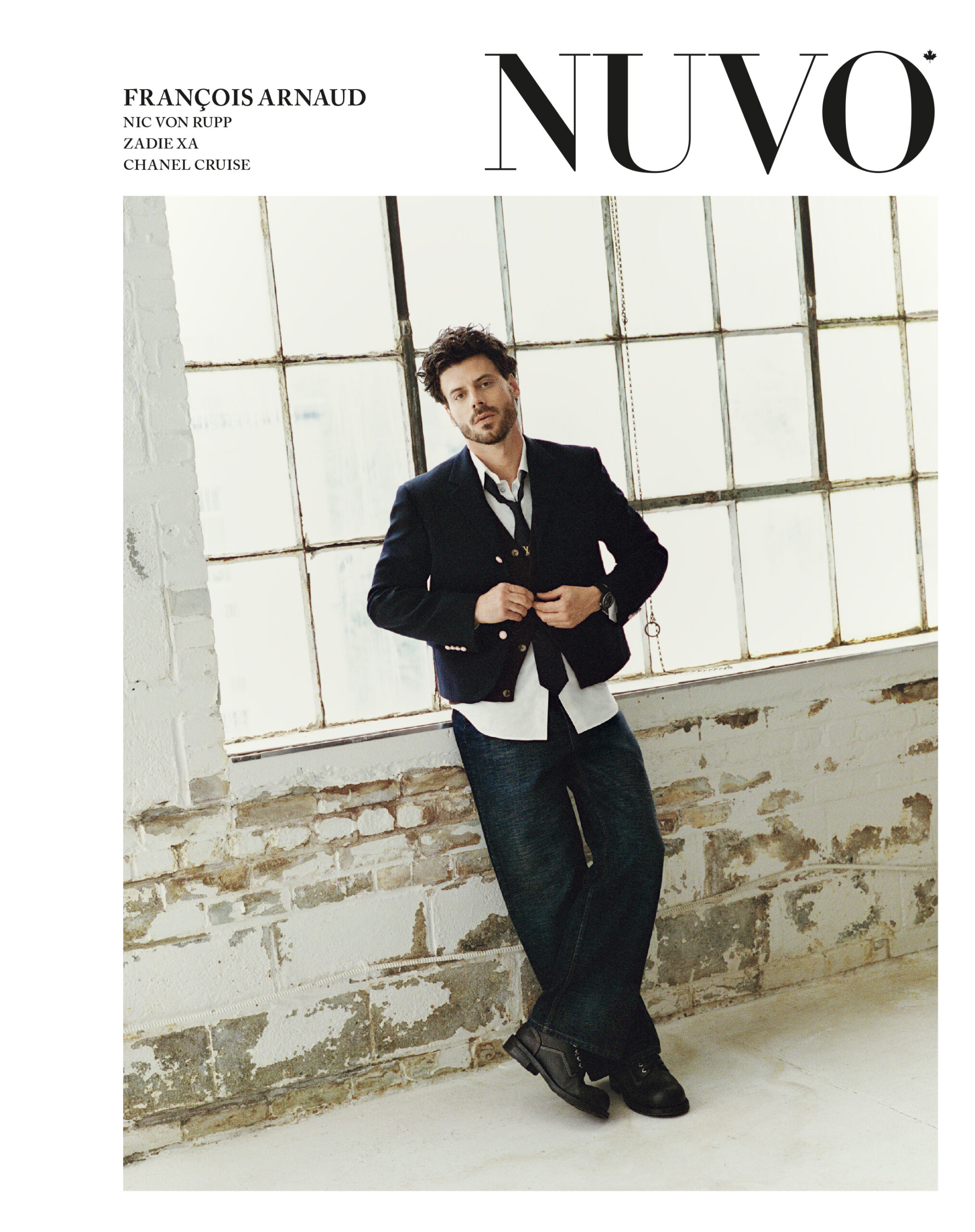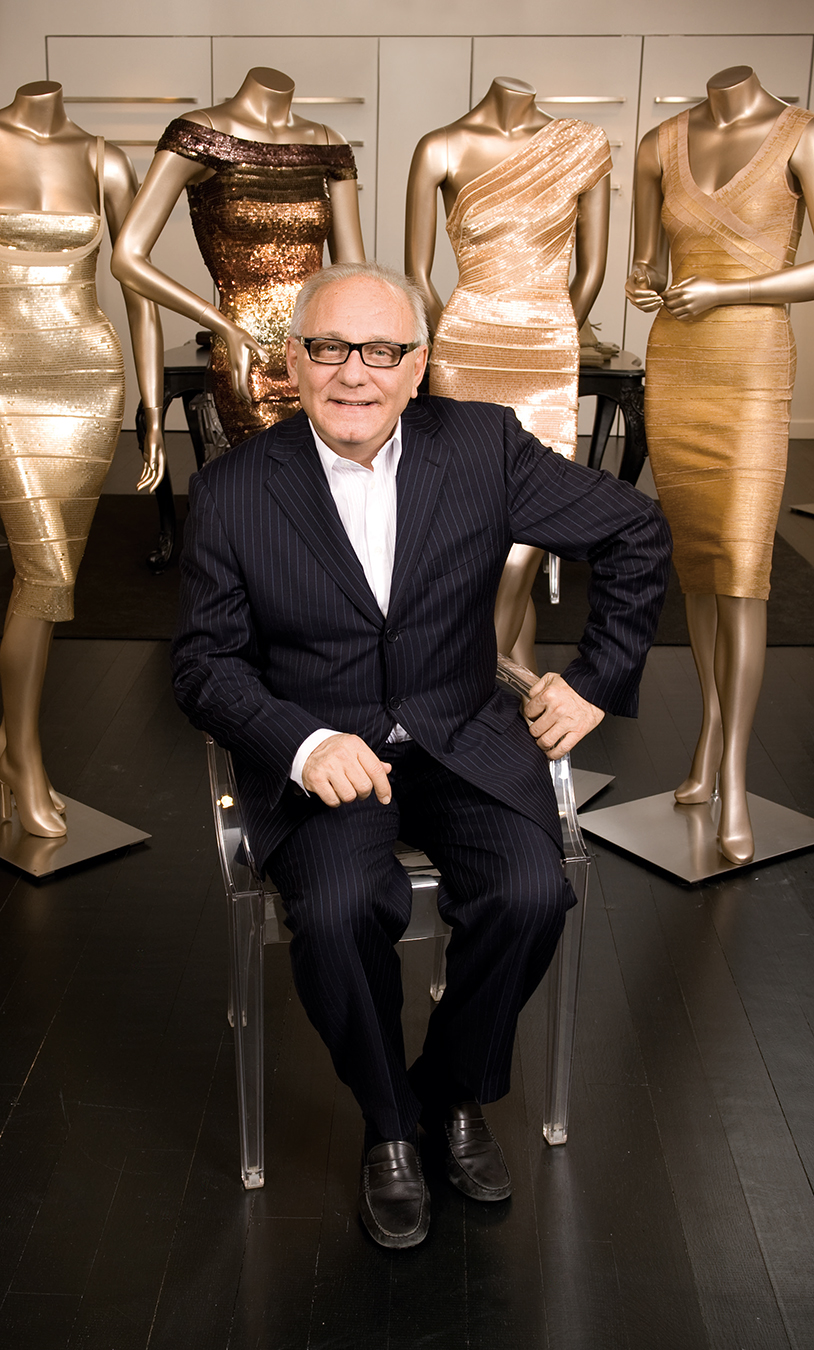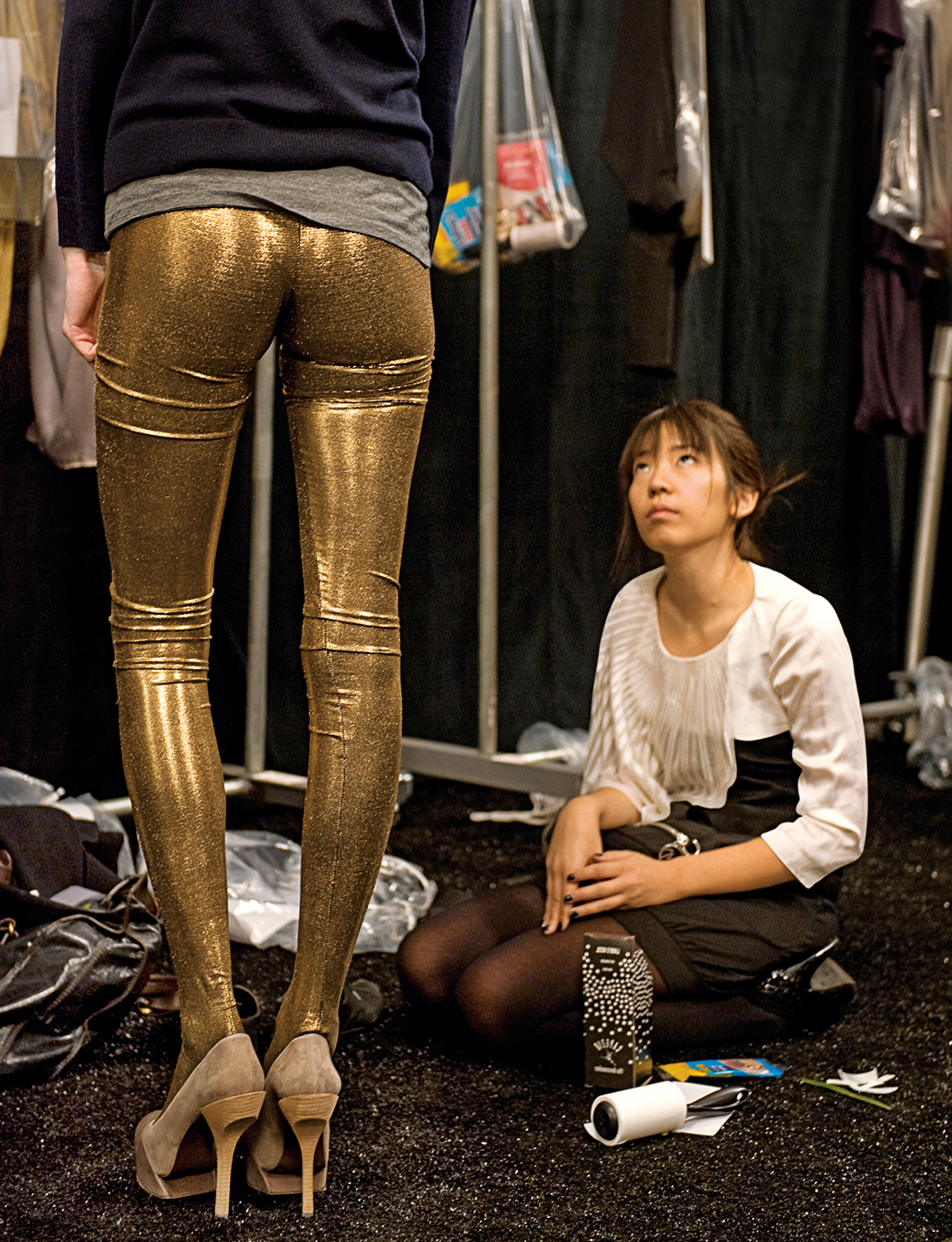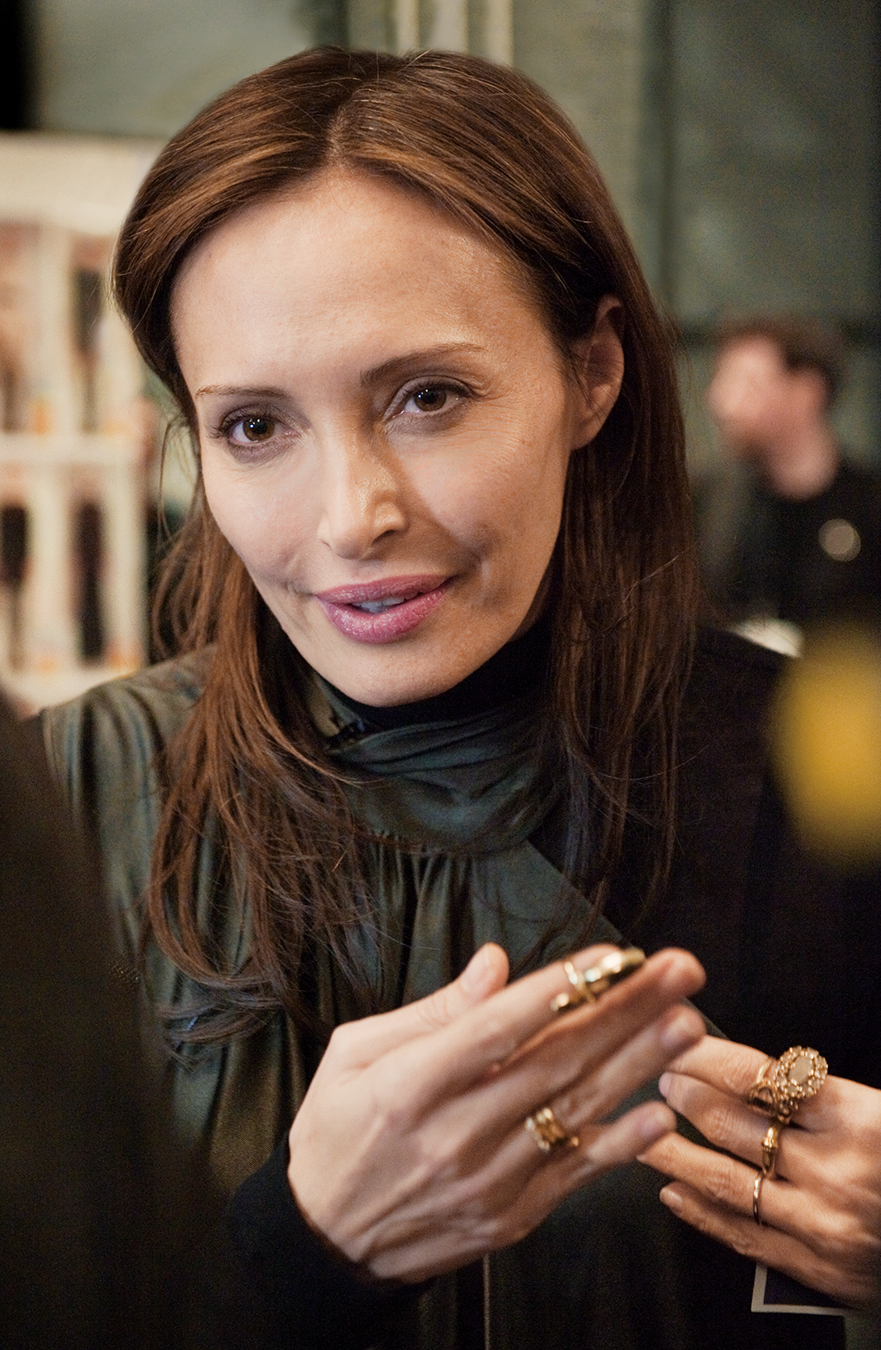Max Azria knows women. And, bless his soul, he gives them what they want. Les femmes, after all, have been the L.A.–based designer’s focus for the last quarter century. “I don’t love just one. I love them all,” he says, with a sly Parisian wink. “Like a good musician knows how to play all the instruments—bass, guitar, piano—I try to play all the different sectors of fashion. And I try to not forget any woman.” Currently, Azria’s eponymous empire handles close to two dozen brands across more than 27 countries, branching out to accessories, fragrances, and evening gowns. That’s a whole lot of love going on.
In 2008, Azria, who recently turned 60, made fashion history when he strode into the Big Apple with three—three—runway presentations. And this year, despite the financial hard knocks that forced other design houses to withdraw from Fall 2009 New York Fashion Week altogether, the mogul once again delivered, bringing his trio of major labels—BCBGMAXAZRIA, Max Azria Collection, and Hervé Léger by Max Azria—to the epicentre of North America: the Tents at Bryant Park.
After learning the couture ropes in Paris and operating a chain of retail stores across France, the Tunisian-born designer made a daring leap over the pond in 1981 to work his Euro panache into the U.S. ladies’ market with a string of boutiques called Jess. A little over a decade later, he opened the first BCBGMAXAZRIA location, in Los Angeles. It wasn’t until 1996, however, that Azria’s premiere runway show dazzled critics in New York, that he garnered a spotlight on the international stage. And it didn’t hurt that red-carpet celebs like Sharon Stone and Demi Moore were paparazzi-ed in his sexy frocks.
It seems everybody in Azria’s circle has style, including the hip employistas abuzz at his midtown Manhattan offices on this Saturday afternoon. In the midst of fashion week mayhem, the company’s chief designer and CEO sits calmly in a black leather chair behind his glass and stainless steel desk. His attentive figure is backlit by panoramic windows 17 storeys above Broadway. To his left, a Dallas Fashion Award stands next to a framed Inc. magazine cover featuring him flanked by two lanky models. Within reach are a stack of glossy industry publications, a small container of cashews, and a pack of Camel Lights.
BCBG, explains Azria, is a Gallic acronym for bon chic, bon genre, which means “good style, good attitude”, a common term in France that Parisians use synonymously with preppy or Euro riche. “I chose that name because that’s the way I would like to see the woman, very chic, and with a good style,” says Azria. “Because many times I said, You can wear the best dress in the world, but if you have a bad attitude, I hope that you don’t buy my dress. Good attitude is really a part of your clothes.”
The BCBGMAXAZRIA line is decidedly the company’s most accessible collection, with offshoots including BCBGeneration, which is aimed at a younger demographic. This season brought 1920s drop waist dresses in glamorous rayon velvet, a comeback material that Azria remembers from 25 years ago. (“We call it bobo in France—bohemian bourgeoisie.”)
“Sometimes, we have a frustration when we cannot do something for BCBG because the cost is too expensive or it’s too sophisticated,” Azria admits. “Max Azria [Collection] is here to complete BCBG.” This season’s runway show was all about fluid fabrics in asymmetrical patterns. At the helm of this middle-sister line is Azria’s wife, Lubov, the Ukrainian-born, Texas-groomed beauty to whom Azria reportedly proposed on their first date. (The two met in L.A. when she interviewed for a job as one of his designers, and they married in 1992.) Often regarded as Azria’s creative partner and proverbial right arm, the House’s first lady also oversees the stores’ decor and runway show ambiance, and she always appears during the final runway bow, holding his hand.
FASHION POWERHOUSE MAX AZRIA IS AT THE HELM OF AN EMPIRE THAT INCLUDES BCBGMAXAZRIA, MAX AZRIA, AND THE RECENTLY ACQUIRED HERVÉ LÉGER.
Azria says, “Our success is fifty-fifty. I fight all my life against ego, so no ego. One time I do more, one time she do more. Basically, I am the bulk of ideas and her strength is in the details.”
For the most part, according to Azria, the two of them discuss fabrics (“because renewing textures is very important”) and volume. “Right now we have a low waistband [for BCBGMAXAZRIA], an inspiration from 1920s, 1930s Europe,” he says. “It changes the whole silhouette.”
Together the couple have three young daughters (Chloe, Anais, and Agnes), all of them with their mother’s Angelina Jolie smile and coveted cheekbones. Azria also has three older children (Michael, Joyce, and Marine) from his previous marriage—and one grandchild. Azria waxes poetic, “Six children is like a guitar—every note, every one is different. I am still learning how to play this guitar.”
This stylish grandpa, however, has a confident grip on Hervé Léger, a line that his company acquired just over 10 years ago. It’s the first time a French couturier—at the time in dire financial straits—was acquired by an American company. Along with the brand, Azria also took over (and subsequently reinvented) the iconic bandage dress, which hugs a woman’s curves the same way one wraps a sprained ankle. Of this acquisition he says, “Hervé Léger excited me immediately because number one it was a great challenge to go to this high level of fashion. And second of all, Hervé Léger’s DNA is about being sexy and being a real woman. It was a challenge for me to take that message and see if I can do something with it. I’m extremely proud of where we are today because the couture aspect was a very difficult work. To do one piece is okay, but to do 200 is much more complicated. We took three years to put everything together. Every Hervé Léger piece has enormous value.”
This season’s Hervé Léger show had a great deal of buzz—along with a Hollywood A-list. Lucy Liu, Rachel Bilson, and Joy Bryant assumed their first row seats as magazine editors sneaked coy glimpses while appearing to look away. Models strutted the catwalk in barely-there makeup anchored by dark, sculpted brows, and hair tightly held back in wildly crimped ponytails.
On hand and eager to comment post-show was star stylist and designer Phillip Bloch, who gushed, “This show was like urban warrior princess goddesses. I think it’s very interesting they tried to make it not so sexified. You know they didn’t go for the big glamorous makeup, the big hair, the big boobs, but they had the big shoulder pads. It was a bit of the eighties, but not the bad part of the eighties—the good part of the eighties.”
Many critics consider Azria to be a key purveyor of French style to the New World. It’s a credit that Azria acknowledges, but from one he feels he has moved beyond. “I don’t believe anymore in Europe style or America style, even Asia style,” he says. “Based on the very fast communication that we have today, and a lot of people travelling south, north, east, west, I think today’s woman is now a woman of the planet. It used to be, you go to Japan and you see another planet. Today, no. With the television, Internet, newspapers, the entire planet gets educated at the same time in the same way. So everybody has only one language in fashion—it’s fashion.”
The entrepreneur in Azria hopes to expand that language into the field of decor. “The home is a part of our new civilization and fashionable way to live. I love this idea because it is a lot about texture, fabric, and colour, and it’s what I do the best. I also dream about going back and doing the men’s collection.” (Azria stopped his full menswear line in 2001 to concentrate on women, although he still offers a few products for men under the BCBGMAXAZRIA/Attitude label.)
Moments of leisure seem scarce for this global guru. But actually, says Azria, “My free time is my work. I do what I want when I want. I love what I do. So really I have 24 hours of free time every day.”









